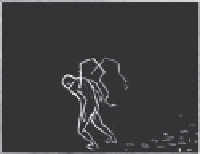Graphics Reference
In-Depth Information
moves that appear to have no fairing in or out. To animate literally like this would suggest very
bad animation as it goes against the smoothness we try to imply. One way to animate such
birds would be to be selective in the jerkiness, still doing large moves, but softening them
slightly at the ends, giving the impressive that the large move was deliberate. In Paul Berry's
brilliant
The Sandman
, the main character contorts his arms to become wings, l apping them
violently, although there's still a softening at the ends. If the arms had just battered back and
forth, the ef ect would have been less successful. It's about giving the illusion of movement, not
the replication of real movement.
For a commercial I had to copy Michael Jackson's
Thriller
, with some shop mannequins coming
to life after hours. The producers were keen for me to replicate the movements exactly.
Reluctantly, I did and the animation looks very ropy. Michael Jackson seemingly dei es the
laws of anatomy through jerky precise sharp moves, but when translated to animation, these
moves look like rough animation. This was an interesting shoot, as we were combining full-
scale mannequins with not very identical puppets, shooting on a set built in a room in an old
castle outside Barcelona. This was long before computer ef ects and the director wanted to i lm
in smoky conditions, much like
Thriller
. Smoke and animation do not mix that well, and with
every window and door taped up to stop draughts, only the essential crew was allowed on set.
I still had to move to animate the puppets and this caused the smoke to swirl around, so I was
encouraged to move in slow motion. The smoke was oil based, and I wore no more than trunks
and a mask as it was so hot and unpleasant. After a shot, the doors were unsealed, and we were
released into a magnii cent garden with a full spread of amazing food laid out. One of those
experiences that don't quite make sense. The i nal commercial was disappointing as it just had
not been possible to replicate
Thriller
, with its sharp movements and all of its smoke ef ects.
An interpretation of the movement would have worked better. The smoke in the animation
sections twitches madly, compared with the slowly drifting smoke in the live-action sections.
A second pass would have been more practical, but the moving puppets would not have
generated their own shadows. In the end, it was the experience of working in a castle in Spain
that was more satisfying.
The illusion of movement
Stop motion is about trying to suggest the illusion of movement, and while it is obvious to
concentrate on the main characters themselves, it's always useful to suggest this movement
with secondary animation. It's an ef ective trick to have something blown about in the wake
of a character. Having things disrupted in an imaginary slipstream makes it look as though the
character is actually moving through physical space and is af ecting its surroundings. It's not,
but the more we can suggest this, the better. If a vehicle races through shot, try to litter the set
with leaves or newspapers that can l utter and l oat about. Those 1970s' detective series knew
how to spice up what probably weren't very dangerous stunts by perpetually driving cars into
cardboard boxes or fruit stalls or through puddles. This suggests great speed or
cause and ef ect. A fast car is exciting, but you only get a sense of the speed and
the danger by seeing an ef ect of this speed. Seeing a car splashing through a
puddle is a real visualisation of the speed. A car going down a straight dry road
with no grass to be rul ed, no newspapers to l y up, no puddles to splash, and no
means to gauge its speed, is less than dynamic. Whenever Toad drove his vehicles,
there were lots of leaves covering the road that l uttered as he went by. We gave


Search WWH ::

Custom Search